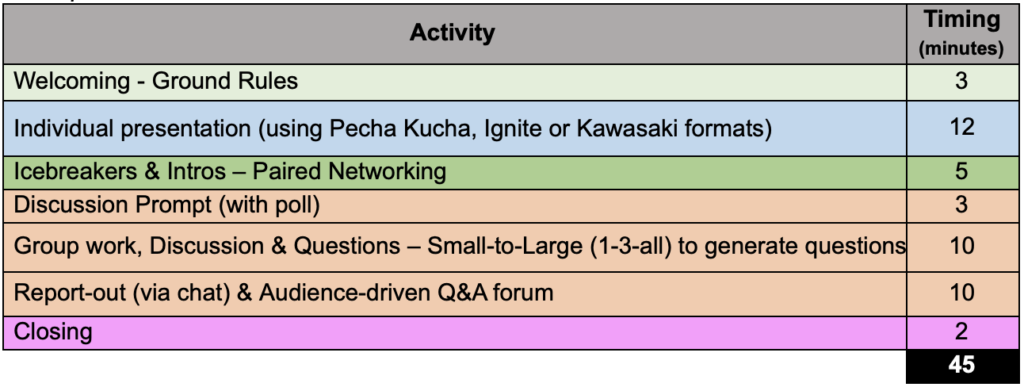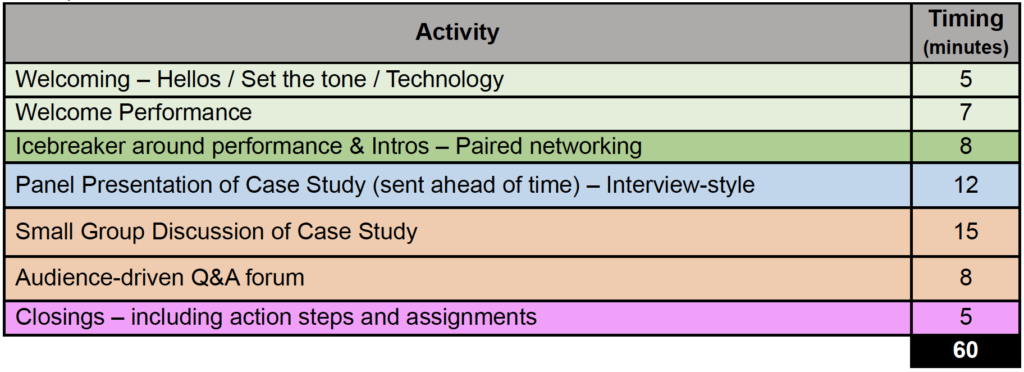AASHE offers educational content in a variety of online formats, including webinars, workshops, courses, and sessions at the annual AASHE conference. This page offers guidelines, best practices and tips * for the three stages of designing, building and delivering an interactive session that will leave attendees feeling energized, inspired and ready to take on the world! If you need help planning your session or have questions about the guidance offered below, please contact us at education@aashe.org.
Typical presentations use a simple format: welcome and introduction followed by the content (usually supported by slides) and a Q&A at the end. However, this format may not be as engaging as you’d like and often lacks the person-to-person connection that attendees look for. Use the guidance below to design your session as a collaborative experience that taps into the expertise of the participants and ultimately leaves them with quality insights and inspiration for the future. Go beyond the typical presentation format and rethink your session to keep the audience engaged, increase learning and retention and, in the case of virtual programs, combat “zoom fatigue”!
Phase 1 – Prepare your proposal
- Start with your audience in mind. Consider what you can offer that is likely to be relevant and useful to attendees and structure your proposal so as to make clear what they will take away from your session or program.
- Engage the audience. Consider best practices shared below for building your session as a collaborative experience which taps into the expertise of the participants and leaves them feeling energized and inspired.
- Focus your proposal on something specific (e.g., the findings of a particular research project; a valuable skill or competency; or an especially successful initiative). We rarely accept proposals that provide a general overview of an institution’s sustainability efforts.
- Highlight the unique or novel aspects of your proposal while still demonstrating relevance to other institutions. For example, if you are proposing a session about your institution’s green fund, be sure to describe any special features that distinguish your green fund from other green funds and that might be useful for other green fund administrators to implement.
- Go deep! Many of our members are seeking advanced, in-depth content.
- Be provocative. We appreciate proposals that thoughtfully challenge conventional wisdom.
- Emphasize the impacts of your research or initiative (e.g., on sustainable behaviors, carbon emissions, or operational costs). Proposals that demonstrate significant real-world impact tend to be reviewed more favorably.
- Describe the evidence you will be using to support your presentation. We especially value presentations that are well supported with evidence and/or empirical research.
- Find partners from other organizations. Proposals that offer insights from multiple institutions engaged in similar work tend to be well received. Posting a message to the AASHE Member Community can be a good way to find potential partners.
- Avoid sales pitches. All sessions must be educational in nature. Proposals that sound like advertisements of a product or service will not be accepted. If you are a supplier of products or services, be sure your proposal focuses on a relevant topic, concept, or idea – not one of your products or services. In addition, most programs require including a campus representative as a presenter to help make the content applicable to the AASHE community.
- Become an AASHE member.
- For the conference: We give preference to submissions featuring people associated with AASHE member organizations and we don’t accept proposals submitted by or featuring non-member businesses (except as a benefit associated with sponsorship).
- For virtual education programs: At least one presenter is required to be affiliated with an AASHE member organization in order to present an AASHE webinar, workshop or course. In addition, as offering a webinar is a benefit of Business Leader membership, we do not accept webinars that include businesses that are not Business Leader members.
- Review the submission fields and prepare your text in advance. We generally provide a template with all the questions asked in the submission form to help you draft your proposal, especially if there are multiple presenters. Remember to use a character count to make sure you don’t exceed the character limits.
- Read the review criteria provided. To be accepted, your proposal will need to score well on at least several of them.
Phase 2 – Prepare your session
Stage 1: Design Your Session & Content
Follow these three simple steps to design your session:
- Review your goals for the session (e.g., demonstrating and practicing a skill, reviewing a research paper, brainstorming solutions, rallying the community around an issue, showcasing a project or initiative) and design around them.
- Within the constraints of the type of program you have been invited to present (e.g., conference session, webinar, workshop), decide on a format that would best support these goals: debate, interview, short individual presentation, case study discussion, etc.
- Choose the activities that would work well with the format and goals you decided.
Practice your planned activities & scenario at least once or twice to make sure the session flows well, addresses your goals, and is within your intended time limits.
- Engaging Formats
- Activities
- Example Session Structure
Stage 2: Plan for Success
Build your session taking into account:
- your time limitation (e.g., webinars are 60 minutes; conference Field Reports or Networking Meetings are 45 minutes; conference Learning Labs are 2 hours and online workshops are typically 3 hours). Be sure to allow plenty of time for interactive activities and questions.
- tried-and-true engagement ideas
- video conferencing best practices
- if using breakout rooms review below how to set them up for success.
- how to create an accessible and inclusive session. We recommend you review this Presenter Toolkit – Creating and Facilitating an Accessible Presentation.
- Online Engagement Ideas
- Breakout Room Best Practices
- Create an Accessible and Inclusive Session
- Prepare Your Slides
Phase 3: Deliver Your Presentation
When preparing to deliver your presentation make sure that you have the necessary hardware and optimized space. Then it is time to test and practice your setup. On the day of your session or recording, review our final tips and be ready for a great session!
- Preparing to Present Live or to Record
- Recording Tools & Assistance (for pre-recorded sessions)
- During the Live Session or Recording
Additional Resources
- Zoom/Video Conferencing Best Practices Revealed in New Research | Tech & Learning
- 6 Easy Steps to Defeat Virtual Meetings Fatigue
- 9 Important Virtual Presentation Tips For You
- How to Take Your Virtual Presenting to the Next Level
- Virtual Meeting Energizers and Check-ins
- Purposeful Play: 5 Favorite Virtual Energizer
- Host Your Own Meaningful Networking Events
- Words Matter – Guidelines on Using Inclusive Language in the Workplace
- Presenter Toolkit – Creating and Facilitating an Accessible Presentation
*This resource is inspired by conversations with Lee Gimpel (founder of Better Meetings) and John Chen (CEO and author of Engaging Virtual Meetings) and discussions with the Professional Development Professionals Community of the American Society of Association Executives.


